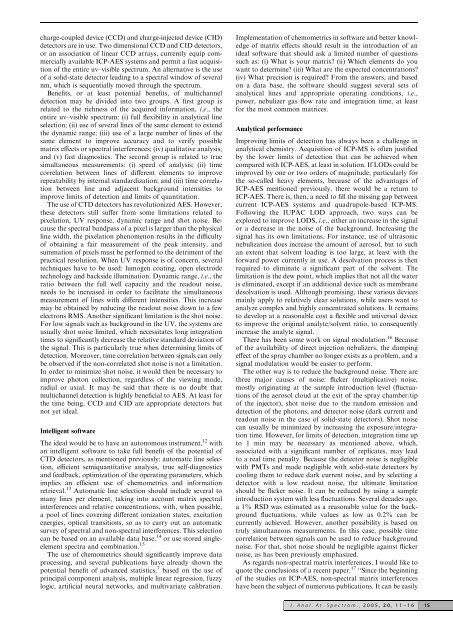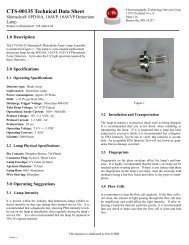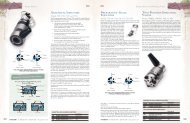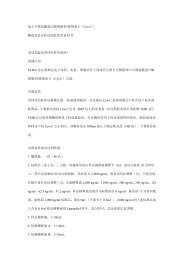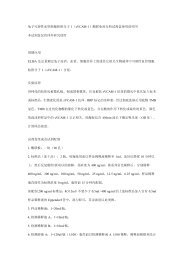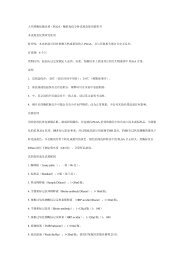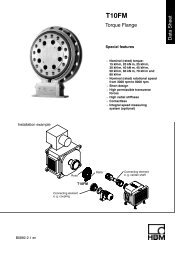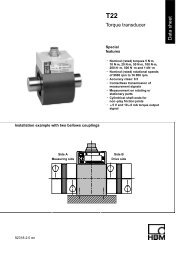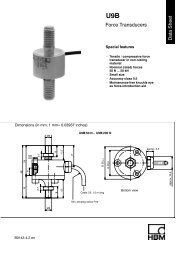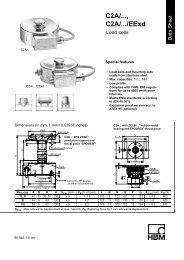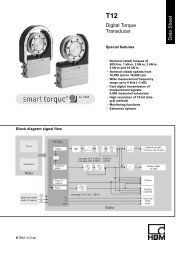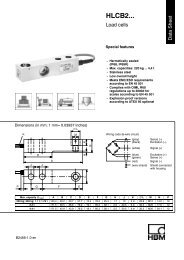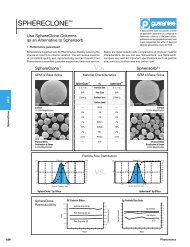Is it still possible, necessary and beneficial to perform research in ...
Is it still possible, necessary and beneficial to perform research in ...
Is it still possible, necessary and beneficial to perform research in ...
You also want an ePaper? Increase the reach of your titles
YUMPU automatically turns print PDFs into web optimized ePapers that Google loves.
charge-coupled device (CCD) <strong>and</strong> charge-<strong>in</strong>jected device (CID)<br />
detec<strong>to</strong>rs are <strong>in</strong> use. Two dimensional CCD <strong>and</strong> CID detec<strong>to</strong>rs,<br />
or an association of l<strong>in</strong>ear CCD arrays, currently equip commercially<br />
available ICP-AES systems <strong>and</strong> perm<strong>it</strong> a fast acquis<strong>it</strong>ion<br />
of the entire uv–visible spectrum. An alternative is the use<br />
of a solid-state detec<strong>to</strong>r lead<strong>in</strong>g <strong>to</strong> a spectral w<strong>in</strong>dow of several<br />
nm, which is sequentially moved through the spectrum.<br />
Benef<strong>it</strong>s, or at least potential benef<strong>it</strong>s, of multichannel<br />
detection may be divided <strong>in</strong><strong>to</strong> two groups. A first group is<br />
related <strong>to</strong> the richness of the acquired <strong>in</strong>formation, i.e., the<br />
entire uv–visible spectrum: (i) full flexibil<strong>it</strong>y <strong>in</strong> analytical l<strong>in</strong>e<br />
selection; (ii) use of several l<strong>in</strong>es of the same element <strong>to</strong> extend<br />
the dynamic range; (iii) use of a large number of l<strong>in</strong>es of the<br />
same element <strong>to</strong> improve accuracy <strong>and</strong> <strong>to</strong> verify <strong>possible</strong><br />
matrix effects or spectral <strong>in</strong>terferences; (iv) qual<strong>it</strong>ative analysis;<br />
<strong>and</strong> (v) fast diagnostics. The second group is related <strong>to</strong> true<br />
simultaneous measurements: (i) speed of analysis; (ii) time<br />
correlation between l<strong>in</strong>es of different elements <strong>to</strong> improve<br />
repeatabil<strong>it</strong>y by <strong>in</strong>ternal st<strong>and</strong>ardization; <strong>and</strong> (iii) time correlation<br />
between l<strong>in</strong>e <strong>and</strong> adjacent background <strong>in</strong>tens<strong>it</strong>ies <strong>to</strong><br />
improve lim<strong>it</strong>s of detection <strong>and</strong> lim<strong>it</strong>s of quant<strong>it</strong>ation.<br />
The use of CTD detec<strong>to</strong>rs has revolutionized AES. However,<br />
these detec<strong>to</strong>rs <strong>still</strong> suffer from some lim<strong>it</strong>ations related <strong>to</strong><br />
pixelation, UV response, dynamic range <strong>and</strong> shot noise. Because<br />
the spectral b<strong>and</strong>pass of a pixel is larger than the physical<br />
l<strong>in</strong>e width, the pixelation phenomenon results <strong>in</strong> the difficulty<br />
of obta<strong>in</strong><strong>in</strong>g a fair measurement of the peak <strong>in</strong>tens<strong>it</strong>y, <strong>and</strong><br />
summation of pixels must be <strong>perform</strong>ed <strong>to</strong> the detriment of the<br />
practical resolution. When UV response is of concern, several<br />
techniques have <strong>to</strong> be used: lumogen coat<strong>in</strong>g, open electrode<br />
technology <strong>and</strong> backside illum<strong>in</strong>ation. Dynamic range, i.e., the<br />
ratio between the full well capac<strong>it</strong>y <strong>and</strong> the readout noise,<br />
needs <strong>to</strong> be <strong>in</strong>creased <strong>in</strong> order <strong>to</strong> facil<strong>it</strong>ate the simultaneous<br />
measurement of l<strong>in</strong>es w<strong>it</strong>h different <strong>in</strong>tens<strong>it</strong>ies. This <strong>in</strong>crease<br />
may be obta<strong>in</strong>ed by reduc<strong>in</strong>g the readout noise down <strong>to</strong> a few<br />
electrons RMS. Another significant lim<strong>it</strong>ation is the shot noise.<br />
For low signals such as background <strong>in</strong> the UV, the systems are<br />
usually shot noise lim<strong>it</strong>ed, which necess<strong>it</strong>ates long <strong>in</strong>tegration<br />
times <strong>to</strong> significantly decrease the relative st<strong>and</strong>ard deviation of<br />
the signal. This is particularly true when determ<strong>in</strong><strong>in</strong>g lim<strong>it</strong>s of<br />
detection. Moreover, time correlation between signals can only<br />
be observed if the non-correlated shot noise is not a lim<strong>it</strong>ation.<br />
In order <strong>to</strong> m<strong>in</strong>imize shot noise, <strong>it</strong> would then be <strong>necessary</strong> <strong>to</strong><br />
improve pho<strong>to</strong>n collection, regardless of the view<strong>in</strong>g mode,<br />
radial or axial. It may be said that there is no doubt that<br />
multichannel detection is highly <strong>beneficial</strong> <strong>to</strong> AES. At least for<br />
the time be<strong>in</strong>g, CCD <strong>and</strong> CID are appropriate detec<strong>to</strong>rs but<br />
not yet ideal.<br />
Intelligent software<br />
The ideal would be <strong>to</strong> have an au<strong>to</strong>nomous <strong>in</strong>strument, 12 w<strong>it</strong>h<br />
an <strong>in</strong>telligent software <strong>to</strong> take full benef<strong>it</strong> of the potential of<br />
CTD detec<strong>to</strong>rs, as mentioned previously: au<strong>to</strong>matic l<strong>in</strong>e selection,<br />
efficient semiquant<strong>it</strong>ative analysis, true self-diagnostics<br />
<strong>and</strong> feedback, optimization of the operat<strong>in</strong>g parameters, which<br />
implies an efficient use of chemometrics <strong>and</strong> <strong>in</strong>formation<br />
retrieval. 13 Au<strong>to</strong>matic l<strong>in</strong>e selection should <strong>in</strong>clude several <strong>to</strong><br />
many l<strong>in</strong>es per element, tak<strong>in</strong>g <strong>in</strong><strong>to</strong> account matrix spectral<br />
<strong>in</strong>terferences <strong>and</strong> relative concentrations, w<strong>it</strong>h, when <strong>possible</strong>,<br />
a pool of l<strong>in</strong>es cover<strong>in</strong>g different ionization states, exc<strong>it</strong>ation<br />
energies, optical trans<strong>it</strong>ions, so as <strong>to</strong> carry out an au<strong>to</strong>matic<br />
survey of spectral <strong>and</strong> non-spectral <strong>in</strong>terferences. This selection<br />
can be based on an available data base, 14 or use s<strong>to</strong>red s<strong>in</strong>gleelement<br />
spectra <strong>and</strong> comb<strong>in</strong>ation. 15<br />
The use of chemometrics should significantly improve data<br />
process<strong>in</strong>g, <strong>and</strong> several publications have already shown the<br />
potential benef<strong>it</strong> of advanced statistics, 7 based on the use of<br />
pr<strong>in</strong>cipal component analysis, multiple l<strong>in</strong>ear regression, fuzzy<br />
logic, artificial neural networks, <strong>and</strong> multivariate calibration.<br />
Implementation of chemometrics <strong>in</strong> software <strong>and</strong> better knowledge<br />
of matrix effects should result <strong>in</strong> the <strong>in</strong>troduction of an<br />
ideal software that should ask a lim<strong>it</strong>ed number of questions<br />
such as: (i) What is your matrix? (ii) Which elements do you<br />
want <strong>to</strong> determ<strong>in</strong>e? (iii) What are the expected concentrations?<br />
(iv) What precision is required? From the answers, <strong>and</strong> based<br />
on a data base, the software should suggest several sets of<br />
analytical l<strong>in</strong>es <strong>and</strong> appropriate operat<strong>in</strong>g cond<strong>it</strong>ions, i.e.,<br />
power, nebulizer gas flow rate <strong>and</strong> <strong>in</strong>tegration time, at least<br />
for the most common matrices.<br />
Analytical <strong>perform</strong>ance<br />
Improv<strong>in</strong>g lim<strong>it</strong>s of detection has always been a challenge <strong>in</strong><br />
analytical chemistry. Acquis<strong>it</strong>ion of ICP-MS is often justified<br />
by the lower lim<strong>it</strong>s of detection that can be achieved when<br />
compared w<strong>it</strong>h ICP-AES, at least <strong>in</strong> solution. If LODs could be<br />
improved by one or two orders of magn<strong>it</strong>ude, particularly for<br />
the so-called heavy elements, because of the advantages of<br />
ICP-AES mentioned previously, there would be a return <strong>to</strong><br />
ICP-AES. There is, then, a need <strong>to</strong> fill the miss<strong>in</strong>g gap between<br />
current ICP-AES systems <strong>and</strong> quadrupole-based ICP-MS.<br />
Follow<strong>in</strong>g the IUPAC LOD approach, two ways can be<br />
explored <strong>to</strong> improve LODS, i.e., e<strong>it</strong>her an <strong>in</strong>crease <strong>in</strong> the signal<br />
or a decrease <strong>in</strong> the noise of the background. Increas<strong>in</strong>g the<br />
signal has <strong>it</strong>s own lim<strong>it</strong>ations. For <strong>in</strong>stance, use of ultrasonic<br />
nebulization does <strong>in</strong>crease the amount of aerosol, but <strong>to</strong> such<br />
an extent that solvent load<strong>in</strong>g is <strong>to</strong>o large, at least w<strong>it</strong>h the<br />
forward power currently <strong>in</strong> use. A desolvation process is then<br />
required <strong>to</strong> elim<strong>in</strong>ate a significant part of the solvent. The<br />
lim<strong>it</strong>ation is the dew po<strong>in</strong>t, which implies that not all the water<br />
is elim<strong>in</strong>ated, except if an add<strong>it</strong>ional device such as membrane<br />
desolvation is used. Although promis<strong>in</strong>g, these various devices<br />
ma<strong>in</strong>ly apply <strong>to</strong> relatively clear solutions, while users want <strong>to</strong><br />
analyze complex <strong>and</strong> highly concentrated solutions. It rema<strong>in</strong>s<br />
<strong>to</strong> develop at a reasonable cost a flexible <strong>and</strong> universal device<br />
<strong>to</strong> improve the orig<strong>in</strong>al analyte/solvent ratio, <strong>to</strong> consequently<br />
<strong>in</strong>crease the analyte signal.<br />
There has been some work on signal modulation. 16 Because<br />
of the availabil<strong>it</strong>y of direct <strong>in</strong>jection nebulizers, the damp<strong>in</strong>g<br />
effect of the spray chamber no longer exists as a problem, <strong>and</strong> a<br />
signal modulation would be easier <strong>to</strong> <strong>perform</strong>.<br />
The other way is <strong>to</strong> reduce the background noise. There are<br />
three major causes of noise: flicker (multiplicative) noise,<br />
mostly orig<strong>in</strong>at<strong>in</strong>g at the sample <strong>in</strong>troduction level (fluctuations<br />
of the aerosol cloud at the ex<strong>it</strong> of the spray chamber/tip<br />
of the <strong>in</strong>jec<strong>to</strong>r), shot noise due <strong>to</strong> the r<strong>and</strong>om emission <strong>and</strong><br />
detection of the pho<strong>to</strong>ns, <strong>and</strong> detec<strong>to</strong>r noise (dark current <strong>and</strong><br />
readout noise <strong>in</strong> the case of solid-state detec<strong>to</strong>rs). Shot noise<br />
can usually be m<strong>in</strong>imized by <strong>in</strong>creas<strong>in</strong>g the exposure/<strong>in</strong>tegration<br />
time. However, for lim<strong>it</strong>s of detection, <strong>in</strong>tegration time up<br />
<strong>to</strong> 1 m<strong>in</strong> may be <strong>necessary</strong> as mentioned above, which,<br />
associated w<strong>it</strong>h a significant number of replicates, may lead<br />
<strong>to</strong> a real time penalty. Because the detec<strong>to</strong>r noise is negligible<br />
w<strong>it</strong>h PMTs <strong>and</strong> made negligible w<strong>it</strong>h solid-state detec<strong>to</strong>rs by<br />
cool<strong>in</strong>g them <strong>to</strong> reduce dark current noise, <strong>and</strong> by select<strong>in</strong>g a<br />
detec<strong>to</strong>r w<strong>it</strong>h a low readout noise, the ultimate lim<strong>it</strong>ation<br />
should be flicker noise. It can be reduced by us<strong>in</strong>g a sample<br />
<strong>in</strong>troduction system w<strong>it</strong>h less fluctuations. Several decades ago,<br />
a 1% RSD was estimated as a reasonable value for the background<br />
fluctuations, while values as low as 0.2% can be<br />
currently achieved. However, another possibil<strong>it</strong>y is based on<br />
truly simultaneous measurements. In this case, <strong>possible</strong> time<br />
correlation between signals can be used <strong>to</strong> reduce background<br />
noise. For that, shot noise should be negligible aga<strong>in</strong>st flicker<br />
noise, as has been previously emphasized.<br />
As regards non-spectral matrix <strong>in</strong>terferences, I would like <strong>to</strong><br />
quote the conclusions of a recent paper. 17 ‘‘S<strong>in</strong>ce the beg<strong>in</strong>n<strong>in</strong>g<br />
of the studies on ICP-AES, non-spectral matrix <strong>in</strong>terferences<br />
have been the subject of numerous publications. It can be easily<br />
J. Anal. At. Spectrom., 2005, 20, 11–16 15


